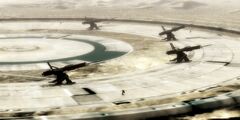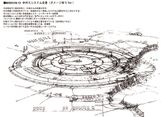- For the Stonehenge from Ace Combat Infinity, see Stonehenge Turret Network (Infinity).
The Stonehenge Turret Network was an asteroid interception complex built in Usea in the 20th century to protect Earth from the Ulysses 1994XF04 asteroid.
Initially conceived by the FCU, it was the first in a series of superweapons developed to combat the impeding impact of the asteroid. It was later captured by Erusea at the peak of international tensions with other countries years after the impact of Ulysses, becoming the catalyst of the Usean Continental War.
History
Creation
Stonehenge was created four years after the Ulysses asteroid was discovered by the International Astronomist Union, being the final result of a series of plans conceived by Usean nations and the FCU to develop a weapons system to combat the celestial body.
The complex was built in a vast desert in the neutral nation of San Salvacion. During the complex's construction, an special group of fighter pilots from the UTO, the STN Guard Squadron, was assigned the task of protecting the site from military attacks. Construction of the cannons was briefly upset by protests from citizens of San Salvacion, who claimed that their builders ignored the historical significance of the land.
Ulysses impact and Erusian takeover

A group of soldiers watching Ulysses from Stonehenge.
The Stonehenge facility entered action when Ulysses reached the Earth's atmosphere in July 3, 1999. The complex engaged the asteroid's fragments, succeeding in limiting the damage suffered by the Usean continent during and after the planetfall event. However, talk arose of STN's potential as a military weapon, leading to meetings and sanctions banning the cannons from being used for warfare.
In the years following the Ulysses disaster, the Republic of Erusea was strained by the amount of refugees in the country, causing friction with the United Nations and neighboring countries. Tensions reached a boiling point in August of 2003, when the Erusian military captured Stonehenge in a military operation. After days of uncertainity surrounding the fate of the complex, Erusea decided to use it to attack other Usean nations, leading to the formation of the ISAF.
Continental War

A shot of the Stonehenge guns.
The newly-formed ISAF was overwhelmed by Stonehenge's firepower, and chose to retreat east to escape from the railguns' effective radius. During the retreat operation, a last-ditch plan was carried out by troops in Los Canas to destroy Stonehenge, which failed as the attack force was annihilated by the 156th Tactical Fighter Wing (Yellow Squadron).
As the allied forces fled, the Erusian government announced a plan to assign the duty of defending Stonehenge to a batch of X-02 Wyverns, Erusea's next-generation aircraft. Debates over the Wyvern's reliability in comparison to conventional aircraft raged within the parliament, eventually halting the X-02's production.
Stonehenge was used against ISAF forces several times during their counteroffensive in 2005 as they destroyed several sites of major importance to Erusea's war effort. In April of that same year, a group of former engineers who worked on STN defected with their families on Air Ixiom airliners to the Allied Forces, offering information on the complex in exchange for amnesty. A weakness in the complex's defenses was realized and a plan of attack was formed, where a squadron of aircraft would approach the complex at low altitude and high speed and attack.
On April 2nd, the ISAF launched a second operation to destroy Stonehenge. Named "Operation Stone Crusher", it involved an Air Force strike group involving several fighters, including ace pilot Mobius One. Avoiding the facility's attack, Mobius destroyed the entire cannon array single-handedly. The Erusian's lynchpin was eliminated; the tide of the war had turned, and ISAF went on the offensive.
Design

Concept art of the STN facility.
Created to intercept the Ulysses asteroid, the Stonehenge facility was built in a desert in San Salvacion, several miles south from the capital of the country. The complex is divided into eight sectors, each of which houses a railgun.
Officially called "120cm-Caliber-Anti-Surface-And-Air Gunpowder-And-Electromagnetic-Propelling Semiautomatic-Fixated Guns", the cannons use a combination of gunpowder and electricity to fire 120cm rounds, the former firing the projectile and the latter propelling it at high speeds.
The railguns were controlled by a complex of 8,192 supercomputers, separated into 1,024 sets of eight, each of which was capable of performing nine billion floating point arithmetic operations per second, which equals a total of 100 trillion operations per second with all computers combined. The system employed data gathered from orbiting satellites and observatories across the globe to simulate the atmospheric conditions of Usea to calculate an asteroid's impact point. After this step, the railguns tracked the target and fired.
Stonehenge's ammunition is capable of achieving speeds of Mach 23, or eight kilometers per second. The use of hybrid energy was chosen because the railguns' barrels could be melted by the Joule heat generated by their use, and the exclusive use of electricity would make constant operations too costly to maintain. The effective range of Stonehenge encompasses a 1,200-mile radius, spanning Farbanti from the western tip of Usea to Faith Park, covering the entire west and central sections of the continent.
Despite its power and effectiveness against aircraft, the Stonehenge Turret Network suffered from several flaws. Firstly, due to its original design of tracking and destroying asteroids, the turrets could not engage targets below 2,000 feet such as military installations or ground troops. The curvature of the Earth and the cannons' straight-firing nature limited their range to Usea alone. However, Stonehenge compensated for these flaws by having a large interlinking network of SAM sites and AA guns encircling the installation, along with fighter wings and jammer technology. However, the ECM jammer is located in the center of the complex, and is vulnerable to machine gun fire. Once destroyed, missiles can be used as normal.
Trivia
- The Meson Cannon complex in Ace Combat X had a similarity in appearance to the Stonehenge, the differences being that the Meson Canoon surrounded a city, fired lasers, and may not have had radar jamming (depends on whether the player destroyed the Nevera jammer first).
- The jamming facility in the center may have been inspiration for the nuclear missile silo doors in the mission "Sanctify" from Ace Combat: Joint Assault.
- The air base next to the turret network is a photo-exact replica of Peterson Air Force Base in Colorado Springs, Colorado. The base was transposed onto a desert-like environment to match the surrounding terrain of Stonehenge.
Gallery
- 38.jpg
Stonehenge Turret Network (Strangereal) in the book Aces At War: A History (1)
- 39.jpg
Stonehenge Turret Network (Strangereal) in the book Aces At War: A History (2)
Sources
- Ace Combat 04: Shattered Skies (the game itself)
- Shatteredskies.net
- Official AC04 website
- PROJECT stonecrusher



